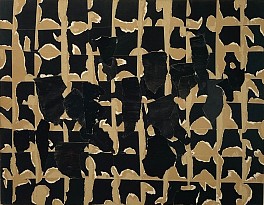BIOGRAPHY

American (1917-2006)
he mid-20th Century was a unique moment in history, when a new generation of American artists, clustered in and around New York— some native and some foreign-born but all more or less assimilated— redefined the European Abstract tradition in terms of a new, jazz-inflected idiom that reflected America's energy, self-confidence and world hegemony. For the first time, American painters would define the international style.
Richenburg was a member of this generation. He studied in New York with Hans Hofmann and took part in the downtown painting scene. He was a member of the Club, the influential group of abstract painters that included Barnett Newman, Willem De Kooning, Ad Reinhart, Joan Mitchell and Robert Motherwell. In 1951 he was invited to be part of the Ninth Street Show, the exhibition that helped to establish the New York School, organized by the Club and supervised by the dealer Leo Castelli.
As the decade continued, he attracted attention from critics such as Dore Ashton and Irving Sandler, and his work entered the collections of the Museum of Modern Art, the Whitney, the Hirshhorn, and the Philadelphia Museum of Art. His recognition reached its height with his Black Paintings, large canvases in which passages of line and color were scraped through black overpainting to project works of remarkable impressiveness and force.
These works simultaneously evoke urban lights and night skies, human energy and natural force. One critic had this to say of these works:
"[Each]work of the series combines an intensely lyric dynamism with a bracing sense of form. Perhaps the closest analogue is the drip paintings of Jackson Pollock, Richenburg's close neighbor in Easthampton, entirely different though their styles and techniques were. A dream exhibit for me would be a roomful of Pollock's drips alternating with Richenburg's black paintings. Richenburg would come off none the worse for the comparison."
Richenburg made more than sixty “Black” paintings over seven years while continuing to explore new approaches. Solo exhibitions at the Tibor de Nagy Gallery, Richenburg’s then dealer, were held almost every year from 1959 to 1961 and 1962 to 1964,
